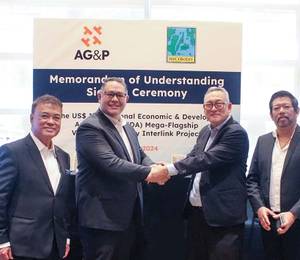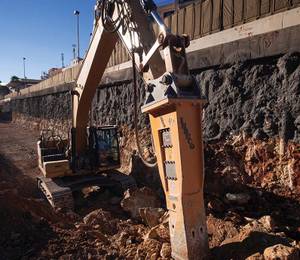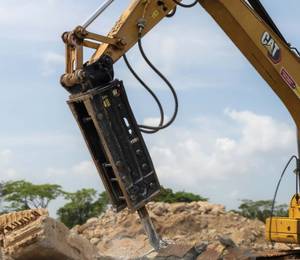Construction of the IOI Central Boulevard Towers in Singapore has reached a major milestone with the topping out of the building. The project is well on track to be completed by the first quarter of 2024. A ceremony to mark this important stage was held on 28 August 2023.
The new mixed-use development will provide approximately 1.26 mil sq ft of Grade A office space and 30,000 sq ft of retail and F&B spaces across the 48-storey West Tower, the 16-storey East Tower and a seven-storey podium. It will also house a 60,000 sq ft, 160-m-long urban sky park called Central Green.
“Today, our vision has become a reality. IOI Central Boulevard Towers stand tall as a spectacular new architectural masterpiece in Singapore’s CBD,” said Lee Yeow Seng, CEO of IOI Properties Group (IOIPG), the project’s developer.
According to IOIPG, the IOI Central Boulevard Towers is the “final piece of the puzzle” in the Marina Bay area, occupying the last plot of land in the CBD (central business district). Among the companies involved in the project are Architects 61, KTP Consultants, Threesixty Cost Management, Hexacon Construction (the contractor), and JRP Group.
Contributing to Singapore’s climate target
The IOI Central Boulevard Towers is part of the Marina Bay District Cooling network. The subscription will enable the building to enjoy reliable cooling comfort without the need to invest in its own chillers, said IOIPG. Besides achieving higher energy savings and reducing the total cost of ownership, it will minimise environmental impact and make a positive difference to Singapore’s climate resilience.
In addition, the IOI Central Boulevard Towers has clinched the BCA’s Green Mark Platinum certification for its extensive slew of innovative green features, including energy-efficient lifts, water-saving fittings and double-glazed facade to reduce carbon footprint.
“The IOI Central Boulevard Towers is an exemplary testament to our group’s resolute commitment to embed sustainability into the entire life cycle of all our developments from design, building to operation. With its myriad of innovative green features and operational strategies anchored on best sustainability practices, the project will push our decarbonisation journey into new frontiers,” said Mr Lee.” We are proud to also contribute to Singapore’s national climate target to achieve net zero emissions by 2050.”
“The building is being constructed with environmentally friendly construction materials. Tenants will also be required to incorporate sustainable practices, for example the use of LED lights,” added Desmond Lee, Singapore’s Minister for National Development and Minister-in-Charge of Social Services Integration. He was the guest of honour at the topping out ceremony, delivering the opening address.
The importance of collaboration between project partners
In his speech, Minister Lee underlined the importance of value chain collaboration and the government’s efforts to help facilitate this collaboration.
“A successful project like this requires many partners to play their part. Thus, alignment and collaboration between project parties is critical for the project to be successfully completed,” he said. “This is especially so as projects become more complex. For instance, in a small city state like Singapore, we will have to build taller, deeper, and in a more integrated manner, amidst our binding land constraints.”
Because of this, the government has been doing more to facilitate collaboration across project parties as part of the refreshed Built Environment Industry Transformation Map (BE ITM), which was launched last year, said Minister Lee.
He shared two initiatives that aim to drive greater upfront collaboration. One of them is Corenet X, which serves as a “one-stop digital shopfront for the industry to make regulatory submissions for building works.
“Under the new approval process, Corenet X will require consultants across different disciplines to collaborate upstream, and submit an integrated building model. This upstream collaboration will facilitate early detection of potential conflicts within the design, which will reduce the time and cost incurred by builders downstream for abortive work.”
According to Minister Lee, agencies will provide consolidated responses to each submission, instead of issuing individual directions in silo. “This coordinated process will enable cross-agency issues and conflicts to be identified and resolved early, in a more systematic manner. We will onboard users in phases and roll out features progressively, beginning with a soft launch of Corenet X in December this year.”
Another initiative is the shift to collaborative contracting, allowing project parties to work with each other. This involves “the use of progressive contracting practices, which can help to manage the risk of disruptions and cost fluctuations amidst volatility and uncertainty,” explained Minister Lee.
“For example, collaborative contracting can encourage project teams to strengthen integration between the design and construction stages, such as through regular workshops and meetings to facilitate communication and open dialogue between parties. Through proactive project management and early warning mechanisms, we can identify issues early before they escalate into major disputes.”
He continued, “Collaborative contracting can also include equitable ‘pain and gain sharing’ mechanisms. For example, there could be clauses that set out the principles of risk-sharing for material price fluctuations. Or clauses that enable the sharing of cost savings, so as to encourage all parties to come up with new and innovative methods to carry out the project.”
With that in mind, Minister Lee pointed out that “developers, who sit at the apex of the value chain by initiating and shaping projects, play a key role in driving value-chain transformation.
“I encourage our private sector developers to join us in these efforts to accelerate transformation in the BE sector and bring up the entire construction industry in Singapore as a whole.”
Images 1, 3, 4 & 5: IOI Properties Group















